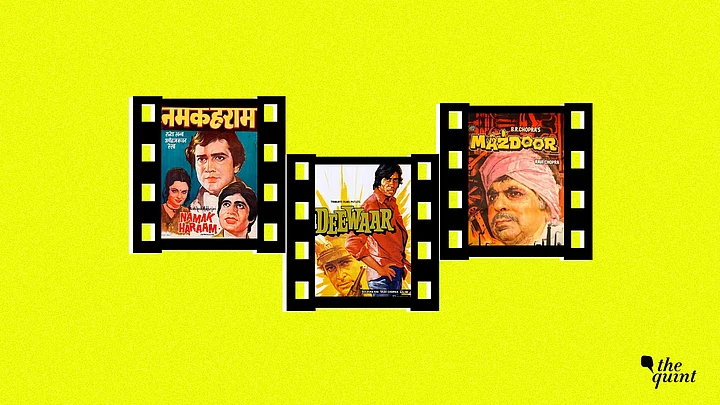Post liberalisation and globalisation Bollywood has fed us a routine diet of these happy rich families and their problems. But there was a time when movies were reflective of the angst and struggles of the working class, which largely also led to Amitabh Bachchan’s ‘angry young man’ image. This Labour Day, we look back at some of the best films that explored these themes and also gave us some memorable characters.
1. Namak Haraam (1973)
There couldn’t have been a more apt filmmaker than Hrishikesh Mukherjee to present the everyman and his problems. Mukherjee tapped into the lives of the middle-class, which then went to become an entire sub genre in Hindi movies. Namak Haraam is about two friends Vicky (Amitabh Bachchan) and Sonu(Rajesh Khanna) and how they navigate their sentiments on class divide. Vicky is humiliated by the union leader of his factory, and so to avenge that, Sonu joins them as a worker and eventually even becomes the union leader. He eventually empathises with the plight of the workers and begins to believe in their ideals. This causes a dent in his friendship with Vicky.
The film was made at a time when textile mills were booming in Mumbai.
2. Mazdoor (1983)
In this film, Mr Sinha, played by the late Nazir Hussain, is a generous mill owner who always distributed his profits amongst his employees. When he dies, his son takes over and changes everything so that he can maximise his own profits. One of the factory mill workers, portrayed by Dilip Kumar, decides to rebel and starts his own mill. An engineer friend of his helps him set up the company and together they create a successful business with a good reputation.
The film was also replete with the kind of kitschy melodrama that we see on Indian television, so if you’re watching the film you know what portions to skip.
3. Deewar (1973)
Most of us remember Deewar for that iconic line delivered by Shashi Kapoor – “Mere paas maa hai.” But the genesis of Amitabh’s need to prove himself, came from the fact that his father was an honest trade union leader who was murdered. As the story goes, Amitabh Bachchan is goaded into becoming an angry young man and eventually a thug after his father was blackmailed by a corrupt businessman and eventually killed by the very workers he was forced to turn against. They also torment the family by shaming them, compelling them to leave their home. His brother, played by Shashi Kapoor, becomes a police officer who is forced to bring him down.
4. Kaala Patthar (1979)
This is one of Yash Chopra’s most underrated films, and boasts of a superlative performance by Amitabh Bachchan. The film is based on the Chasnala coal mining disaster, where AB plays Vijay, a disgraced ex-merchant navy officer who becomes a coal miner. There are some really poignant moments in the film like the scene where Vijay tells Raakhee, “Pain is in my destiny, doctor.” This was another angst-ridden character, and had a delicious counterpart in Shatrughan Sinha as the rival mill worker.
Vijay also has to fight his greedy boss who doesn’t give the labourers good equipment and puts their lives at stake. It’s an ‘angry’ movie in the truest sense but also reflective of the issues that real miners have faced.
5. Do Bigha Zameen (1953)
The central theme of the film revolves around a farmer whose land needs to be taken to create space for industrialisation. This rings a bell now as well, doesn’t it? Balraj Sahni plays Shambhu who owns a meagre two bighas (a type of measurement). His two bighas are a part of a larger chunk of land that the local zamindar wants to purchase. Shambhu owes the landlord money, and so the landlord asks him to exchange his land for the debt Shambhu owes him. When Shambhu disagrees, the zamindar threatens to auction the land which would lead to Shambhu losing his only means of livelihood.
Balraj Sahni’s performance as the naive and innocent Shambhu is still as heart-warming and the song ‘Dharti Kahe Pukaar Ke’ is still apt to describe the plight of farmers.
6. Naya Daur (1957)
The Dilip Kumar starrer is about a ‘tongawalla’- someone who rides a tonga (horse cart), whose bread and butter is threatened when a rich landlord starts a bus service. The film is reflective of the industrialisation that was creeping into India post independence. It was a classic story of ‘Man vs machine’, and the gap that technology was causing. When the tongawallas protest against the introduction of the bus service, the landlord proposes a competition between the two by having a race. Whoever wins would be regarded as the best mode of transport, and the other must accept defeat.
The final race between Dilip Kumar on the tonga and the landlord is still as riveting.
(At The Quint, we question everything. Play an active role in shaping our journalism by becoming a member today.)
